Seasonal Dynamics, Environmental Drivers, and Hysteresis of Sap Flow in Forests of China’s Subtropical Transitional Zone
Abstract
1. Introduction
2. Methods
2.1. Study Area
2.2. Measurement and Calculation of Sap Flow
2.3. Calculation of Sapwood Area and Transpiration
2.4. Observation of Meteorological Variables
2.5. Statistical Analysis
3. Results
3.1. Sap Flow Differences Among Evergreen Broad-Leaved, Bamboo, and Fir Forests
3.2. Effects of Meteorological Factors on Transpiration
3.3. Variation of Sap Flow Under Shifting Environmental Conditions
3.4. The Difference in the Variability of Sap Flow and Major Environment Factors
4. Discussion
4.1. Comparison of Sap Flow Among Different Vegetations
4.2. Influence of Environmental Factors on Sap Flow
4.3. The Time Lag of Sap Flow in Different Species
4.4. Practical Implications
5. Conclusions
Supplementary Materials
Author Contributions
Funding
Data Availability Statement
Acknowledgments
Conflicts of Interest
References
- Oki, T.; Kanae, S. Global hydrological cycles and world water resources. Science 2006, 313, 1068–1072. [Google Scholar] [CrossRef]
- Zheng, C.; Jia, L.; Hu, G. Global land surface evapotranspiration monitoring by ETMonitor model driven by multi-source satellite earth observations. J. Hydrol. 2022, 613, 128444. [Google Scholar] [CrossRef]
- Wang, Q.; Cheng, L.; Zhang, L.; Liu, P.; Qin, S.; Liu, L.; Jing, Z. Quantifying the impacts of land-cover changes on global evapotranspiration based on the continuous remote sensing observations during 1982–2016. J. Hydrol. 2021, 598, 126231. [Google Scholar] [CrossRef]
- Eberbach, P.L.; Burrows, G.E. The transpiration response by four topographically distributed Eucalyptus species, to rainfall occurring during drought in south eastern Australia. Physiol. Plant. 2006, 127, 483–493. [Google Scholar] [CrossRef]
- Calder, I.R. The measurement of water losses from a forested area using a “natural” lysimeter. J. Hydrol. 1976, 30, 311–325. [Google Scholar] [CrossRef]
- Fu, G.; Charles, S.P.; Yu, J. A critical overview of pan evaporation trends over the last 50 years. Clim. Change 2009, 97, 193–214. [Google Scholar] [CrossRef]
- Ni, G.; Zhao, P.; Hou, Y.; Bai, X.; Zhang, L.; Yuan, J.; Ouyang, L.; Liu, F.; Zhu, L.; Zhao, X. Coordination of water use strategies and leaf economic traits in coexisting exotic and native woody species from evergreen and deciduous broadleaf forests. Sci. Total Environ. 2024, 946, 173936. [Google Scholar] [CrossRef]
- Hu, W.; Bachofen, C.; Li, Y.; Zhu, L.; Zhao, P.; Grossiord, C. Soil warming alters tree water use and canopy stomatal conductance in a mixed subtropical forest. Agric. For. Meteorol. 2024, 353, 110073. [Google Scholar] [CrossRef]
- Granier, A. Evaluation of transpiration in a Douglas-fir stand by means of sap flow measurements. Tree Physiol. 1987, 3, 309–320. [Google Scholar] [CrossRef] [PubMed]
- Wimmler, M.-C.; Nadezhdina, N.; Bowen, H.; Alvarado-Barrientos, S.; David, T.; Fontenla-Razzetto, G.; Kniesel, B.; Lange, H.; Link, R.M.; Liu, Y.; et al. Sap Flow Analyzer: A tool to standardize sap flow estimation and scaling to whole-tree water use using the HFD method. Methods Ecol. Evol. 2024, 15, 1532–1539. [Google Scholar] [CrossRef]
- Zhao, X.; Fan, J. Response of tree sap flow rate to soil water and atmospheric environment, and adaptability to drought in the Loess Plateau region of China. For. Ecol. Manag. 2024, 565, 122007. [Google Scholar] [CrossRef]
- Litvak, E.; Pataki, D.E. The influence of climate and management on transpiration of residential trees during a bark beetle infestation. Ecosphere 2024, 15, e4881. [Google Scholar] [CrossRef]
- Oogathoo, S.; Houle, D.; Duchesne, L.; Kneeshaw, D. Vapour pressure deficit and solar radiation are the major drivers of transpiration of balsam fir and black spruce tree species in humid boreal regions, even during a short-term drought. Agric. For. Meteorol. 2020, 291, 108063. [Google Scholar] [CrossRef]
- Zhai, Q.; Xu, L.; Zhang, T.; Guo, J.; Gao, H.; Jiao, R.; Yang, B. Transpiration water consumption by Salix matsudana and Populus simonii and water use patterns at different developmental stages on sandy land. Water 2023, 15, 4255. [Google Scholar] [CrossRef]
- Wu, W.; Li, Y.; Manevski, K.; Andersen, M.N.; Si, B.; Lou, Y.; Feng, H.; Siddique, K.H.M. Transpiration and water use strategies of three economic tree species in a semi-arid afforestation region. Eur. J. For. Res. 2024, 144, 53–68. [Google Scholar] [CrossRef]
- Grossiord, C.; Buckley, T.N.; Cernusak, L.A.; Novick, K.A.; Poulter, B.; Siegwolf, R.T.W.; Sperry, J.S.; McDowell, N.G. Plant responses to rising vapor pressure deficit. New Phytol. Found. 2020, 226, 1550–1566. [Google Scholar] [CrossRef] [PubMed]
- Chen, X.; Zhao, P.; Hu, Y.; Ouyang, L.; Zhu, L.; Ni, G. Canopy transpiration and its cooling effect of three urban tree species in a subtropical city- Guangzhou, China. Urban For. Urban Green. 2019, 43, 126368. [Google Scholar] [CrossRef]
- Han, S.; Wang, Q.; Zhao, Y.; Zhai, J.; Wang, X.; Hao, Y.; Li, L.; Li, X.; Li, H.; Cao, J. Response of typical tree species sap flow to environmental factors in the hilly areas of Haihe River Basin, China. Forests 2024, 15, 294. [Google Scholar] [CrossRef]
- Nalevanková, P.; Sitková, Z.; Kučera, J.; Střelcová, K. Impact of water deficit on seasonal and diurnal dynamics of European beech transpiration and time-lag effect between stand transpiration and environmental drivers. Water 2020, 12, 3437. [Google Scholar] [CrossRef]
- Zhao, C.; Si, J.; Feng, Q.; Chang, Z.; Yu, T.; Li, W. Time lag characteristics of stem sap flow of Populus euphratica in desert riparian forest. J. Desert Res. 2014, 34, 1254–1260. [Google Scholar] [CrossRef]
- Chen, J.; Ouyang, X.; Huang, D.; Liu, S.; Zhang, D.; Li, Y. Sap flow characteristics of four dominant tree species in a mixed conifer-broadleaf forest in Dinghushan. Acta Ecol. Sin. 2015, 35, 4097–4104. [Google Scholar] [CrossRef]
- Zeng, X.; Xu, X.; Yi, R.; Zhong, F.; Zhang, Y. Sap flow and plant water sources for typical vegetation in a subtropical humid karst area of southwest China. Hydrol. Process. 2021, 35, e14090. [Google Scholar] [CrossRef]
- Chen, Q.; Zou, Q.; Liu, Y.; Lan, L.; Mo, X.; Gao, Y.; Yuan, X.; Huang, J.; Fu, X.; Li, L.; et al. Analysis on the transpiration response of Japanese cedar (Crytomeria fortunei) and influencing factors after expansion of moso bamboo (Phyllostachys edulis). Ecol. Indic. 2023, 154, 110636. [Google Scholar] [CrossRef]
- Lin, Y.; Zhang, Y.; Zhao, W.; Zhang, X.; Dong, Y.; Fei, X.; Li, J. Comparison of transpiration characteristics in different aged rubber plantations. Chin. J. Ecol. 2016, 35, 855–863. [Google Scholar] [CrossRef]
- Ouyang, L.; Lu, L.; Wang, C.; Li, Y.; Wang, J.; Zhao, X.; Gao, L.; Zhu, L.; Ni, G.; Zhao, P. A 14-year experiment emphasizes the important role of heat factors in regulating tree transpiration, growth, and water use efficiency of Schima superba in South China. Agric. Water Manag. 2022, 273, 107902. [Google Scholar] [CrossRef]
- Xie, J.; Wan, X. The accuracy of the thermal dissipation technique for estimating sap flow is affected by the radial distribution of conduit diameter and density. Acta Physiol. Plant. 2018, 40, 88. [Google Scholar] [CrossRef]
- Zhao, X.; Zhao, P.; Zhang, Z.; Zhu, L.; Niu, J.; Ni, G.; Hu, Y.; Ouyang, L. Sap flow-based transpiration in Phyllostachys pubescens: Applicability of the TDP methodology, age effect and rhizome role. Trees 2017, 31, 765–779. [Google Scholar] [CrossRef]
- Oishi, A.C.; Hawthorne, D.A.; Oren, R. Baseliner: An open-source, interactive tool for processing sap flux data from thermal dissipation probes. SoftwareX 2016, 5, 139–143. [Google Scholar] [CrossRef]
- Allen, R.; Pereira, L.; Smith, M. Crop Evapotranspiration-Guidelines for Computing Crop Water Requirements; FAO Irrigation and Drainage Paper 56; FAO: Rome, Italy, 1998; Volume 56. [Google Scholar]
- Forster, M.A. How significant is nocturnal sap flow? Tree Physiol. 2014, 34, 757–765. [Google Scholar] [CrossRef]
- Huang, K.; Wang, Q.; Otieno, D. Responses of sap flux densities of different plant functional types to environmental variables are similar in both dry and wet seasons in a subtropical mixed forest. Forests 2021, 12, 1007. [Google Scholar] [CrossRef]
- Li, Y.; Zhu, L.; Ouyang, L.; Zhao, X.; Zhao, P. Environmental controls on transpiration of Schima superba trees with different tree sizes under ten years’ climate fluctuations in south subtropics, China. For. Ecol. Manag. 2023, 539, 120995. [Google Scholar] [CrossRef]
- Rosado, B.H.P.; Oliveira, R.S.; Joly, C.A.; Aidar, M.P.M.; Burgess, S.S.O. Diversity in nighttime transpiration behavior of woody species of the Atlantic Rain Forest, Brazil. Agric. For. Meteorol. 2012, 158–159, 13–20. [Google Scholar] [CrossRef]
- Kobayashi, N.; Kumagai, T.o.; Miyazawa, Y.; Matsumoto, K.; Tateishi, M.; Lim, T.K.; Mudd, R.G.; Ziegler, A.D.; Giambelluca, T.W.; Yin, S. Transpiration characteristics of a rubber plantation in central Cambodia. Tree Physiol. 2014, 34, 285–301. [Google Scholar] [CrossRef]
- Chen, L.; Zhang, Z.; Li, Z.; Tang, J.; Caldwell, P.; Zhang, W. Biophysical control of whole tree transpiration under an urban environment in Northern China. J. Hydrol. 2011, 402, 388–400. [Google Scholar] [CrossRef]
- Dierick, D.; Hölscher, D.; Schwendenmann, L. Water use characteristics of a bamboo species (Bambusa blumeana) in the Philippines. Agric. For. Meteorol. 2010, 150, 1568–1578. [Google Scholar] [CrossRef]
- Maguire, D.A. Branch mortality and potential litterfall from Douglas-fir trees in stands of varying density. For. Ecol. Manag. 1994, 70, 41–53. [Google Scholar] [CrossRef]
- Ishii, H.; McDowell, N. Age-related development of crown structure in coastal Douglas-fir trees. For. Ecol. Manag. 2002, 169, 257–270. [Google Scholar] [CrossRef]
- Wang, Z.; Du, A.; Liu, S.; Xu, Y.; Zhu, W.; Xiang, W. Quantification of nocturnal water use and its composition in a Eucalyptus urophylla × E. grandis plantation on the Leizhou Peninsula, South China. J. Geophys. Res. Biogeosciences 2024, 129, e2023JG007779. [Google Scholar] [CrossRef]
- Hayat, M.; Zha, T.; Jia, X.; Iqbal, S.; Qian, D.; Bourque, C.P.A.; Khan, A.; Tian, Y.; Bai, Y.; Liu, P.; et al. A multiple-temporal scale analysis of biophysical control of sap flow in Salix psammophila growing in a semiarid shrubland ecosystem of northwest China. Agric. For. Meteorol. 2020, 288–289, 107985. [Google Scholar] [CrossRef]
- Fang, W.; Lü, N.; Fu, B. Research advances in nighttime sap flow density, its physiological implications, and influencing factors in plants. Acta Ecol. Sin. 2018, 38, 861–865. [Google Scholar] [CrossRef]
- Snyder, K.A.; Richards, J.H.; Donovan, L.A. Night-time conductance in C3 and C4 species: Do plants lose water at night? J. Exp. Bot. 2003, 54, 861–865. [Google Scholar] [CrossRef] [PubMed]
- Wang, H.; Zhao, P.; Hölscher, D.; Wang, Q.; Lu, P.; Cai, X.A.; Zeng, X.P. Nighttime sap flow of Acacia mangium and its implications for nighttime transpiration and stem water storage. J. Plant Ecol. 2012, 5, 294–304. [Google Scholar] [CrossRef]
- Ma, L.; Lu, P.; Zhao, P.; Rao, X.-q.; Cai, X.-a.; Zeng, X.-p. Diurnal, daily, seasonal and annual patterns of sap-flux-scaled transpiration from an Acacia mangium plantation in South China. Ann. For. Sci. 2008, 65, 402. [Google Scholar] [CrossRef]
- Kumarathunge, D.P.; Medlyn, B.E.; Drake, J.E.; De Kauwe, M.G.; Tjoelker, M.G.; Aspinwall, M.J.; Barton, C.V.M.; Campany, C.E.; Crous, K.Y.; Yang, J.; et al. Photosynthetic temperature responses in leaves and canopies: Why temperature optima may disagree at different scales. Tree Physiol. 2024, 44, 135. [Google Scholar] [CrossRef]
- Li, X.; Xiao, J.; He, B. Higher absorbed solar radiation partly offset the negative effects of water stress on the photosynthesis of Amazon forests during the 2015 drought. Environ. Res. Lett. 2018, 13, 044005. [Google Scholar] [CrossRef]
- Li, F.; Xiao, J.; Chen, J.; Ballantyne, A.; Jin, K.; Li, B.; Abraha, M.; John, R. Global water use efficiency saturation due to increased vapor pressure deficit. Science 2023, 381, 672–677. [Google Scholar] [CrossRef] [PubMed]
- Tie, Q.; Hu, H.; Tian, F.; Guan, H.; Lin, H. Environmental and physiological controls on sap flow in a subhumid mountainous catchment in North China. Agric. For. Meteorol. 2017, 240–241, 46–57. [Google Scholar] [CrossRef]
- Clausnitzer, F.; Köstner, B.; Schwärzel, K.; Bernhofer, C. Relationships between canopy transpiration, atmospheric conditions and soil water availability—Analyses of long-term sap-flow measurements in an old Norway spruce forest at the Ore Mountains/Germany. Agric. For. Meteorol. 2011, 151, 1023–1034. [Google Scholar] [CrossRef]
- Iqbal, S.; Zha, T.; Jia, X.; Hayat, M.; Qian, D.; Bourque, C.P.A.; Tian, Y.; Bai, Y.; Liu, P.; Yang, R.; et al. Interannual variation in sap flow response in three xeric shrub species to periodic drought. Agric. For. Meteorol. 2021, 297, 108276. [Google Scholar] [CrossRef]
- Hadiwijaya, B.; Pepin, S.; Isabelle, P.-E.; Nadeau, D.F. The dynamics of transpiration to evapotranspiration ratio under wet and dry canopy conditions in a humid boreal forest. Forests 2020, 11, 237. [Google Scholar] [CrossRef]
- Wei, X.; Li, B.; Guo, C.; Wang, Y.; He, J.; Shouyang, L.; Wang, T.; Yao, M. Identification of sap flow driving factors of jujube plantation in semi-arid areas in Northwest China. Int. J. Agric. Biol. Eng. 2017, 10, 172–183. [Google Scholar] [CrossRef]
- De Deurwaerder, H.P.T.; Visser, M.D.; Meunier, F.; Detto, M.; Hervé-Fernández, P.; Boeckx, P.; Verbeeck, H. Robust estimation of absorbing root surface distributions from xylem water isotope compositions with an inverse plant hydraulic model. Front. For. Glob. Change 2021, 4, 689335. [Google Scholar] [CrossRef]
- Liu, X.; Ma, X.; Di, N.; Zeng, Z.-H.; Fu, H.-M.; Li, X.; Xi, B.-Y. Root sap flow and hydraulic redistribution of Populus tomentosa. Chin. J. Plant Ecol. 2023, 47, 123–133. [Google Scholar] [CrossRef]
- Wan, L.; Zhang, Q.; Cheng, L.; Liu, Y.; Qin, S.; Xu, J.; Wang, Y. What determines the time lags of sap flux with solar radiation and vapor pressure deficit? Agric. For. Meteorol. 2023, 333, 109414. [Google Scholar] [CrossRef]
- Bariac, T.; Rambal, S.; Jusserand, C.; Berger, A. Evaluating water fluxes of field-grown alfalfa from diurnal observations of natural isotope concentrations, energy budget and ecophysiological parameters. Agric. For. Meteorol. 1989, 48, 263–283. [Google Scholar] [CrossRef]
- Xu, J.; Ma, L.; Yan, H. Relationship between process of sap flow of P. tabulaeformis and solar radiation. Sci. Soil Water Conserv. 2006, 4, 103–107. [Google Scholar]
- Wang, H.; Zhao, P.; Cai, X.; Ma, L.; Rao, X.; Zeng, X. Time lag effect between stem sap flow and photosynthetically active radiation, vapor pressure deficit of Acacia mangium. Chin. J. Appl. Ecol. 2008, 19, 225–230. [Google Scholar]
- Zeppel, M.J.B.; Murray, B.R.; Barton, C.; Eamus, D. Seasonal responses of xylem sap velocity to VPD and solar radiation during drought in a stand of native trees in temperate Australia. Funct. Plant Biol. 2004, 31, 461–470. [Google Scholar] [CrossRef]
- O’Brien, J.J.; Oberbauer, S.F.; Clark, D.B. Whole tree xylem sap flow responses to multiple environmental variables in a wet tropical forest. Plant Cell Environ. 2004, 27, 551–567. [Google Scholar] [CrossRef]
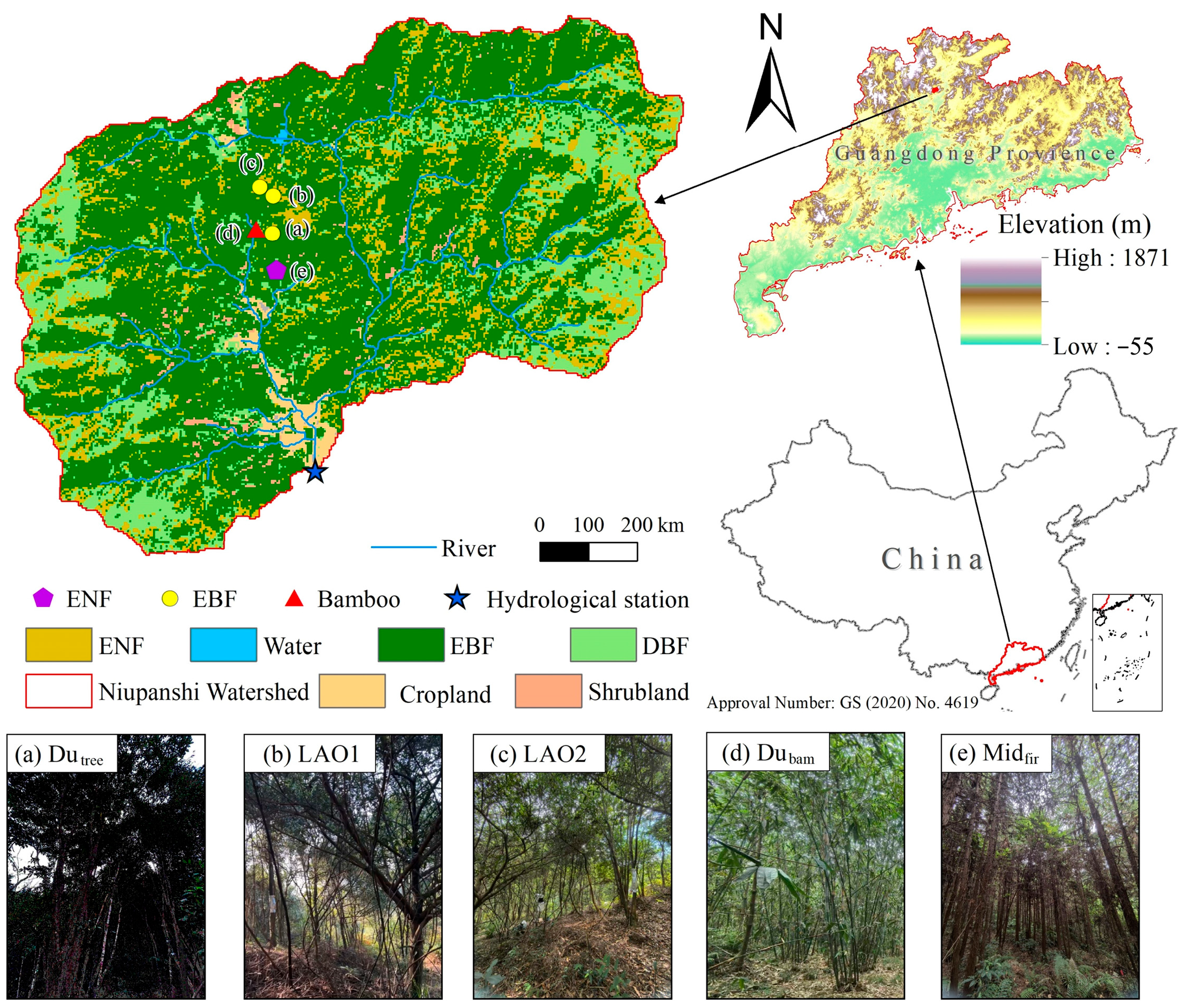
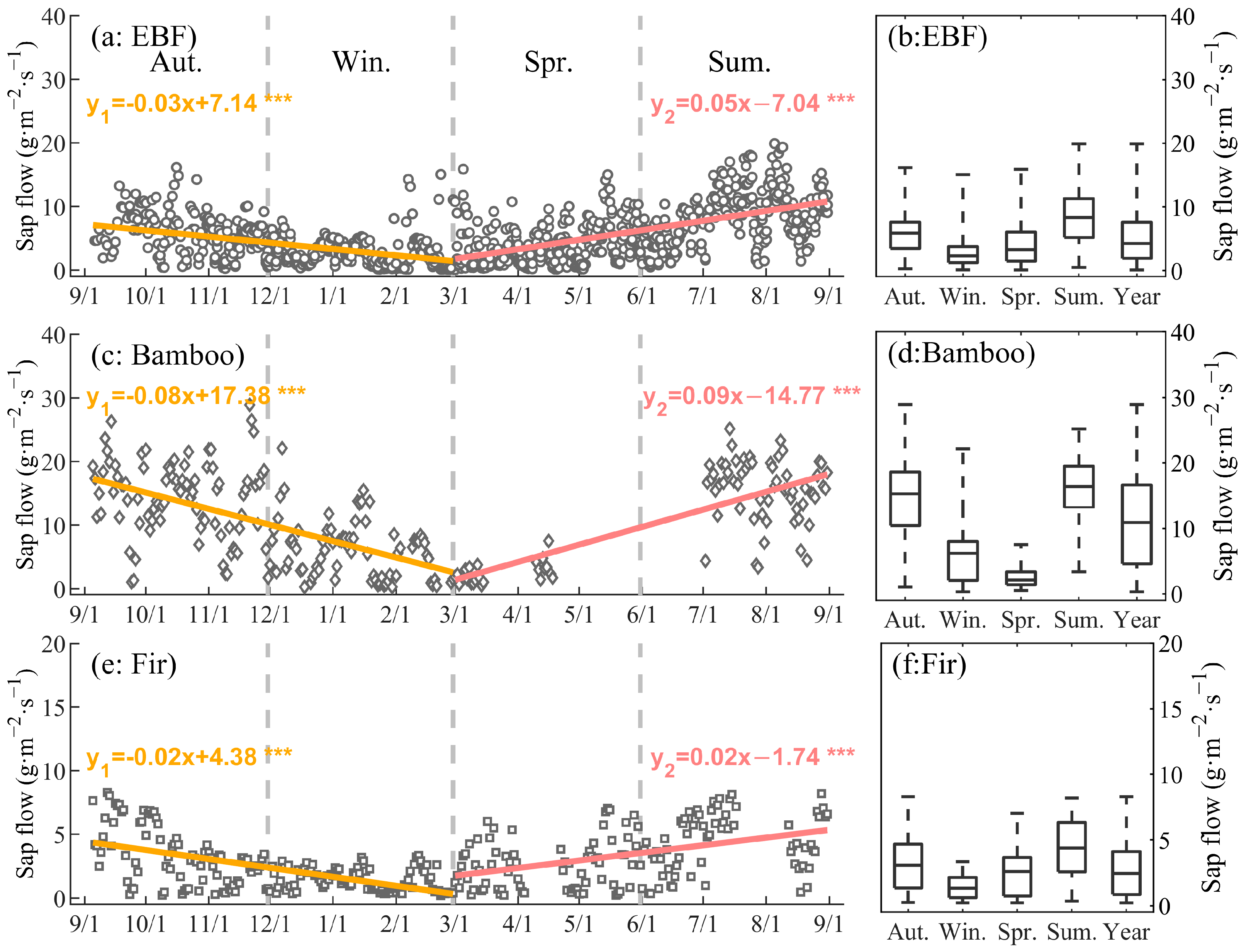
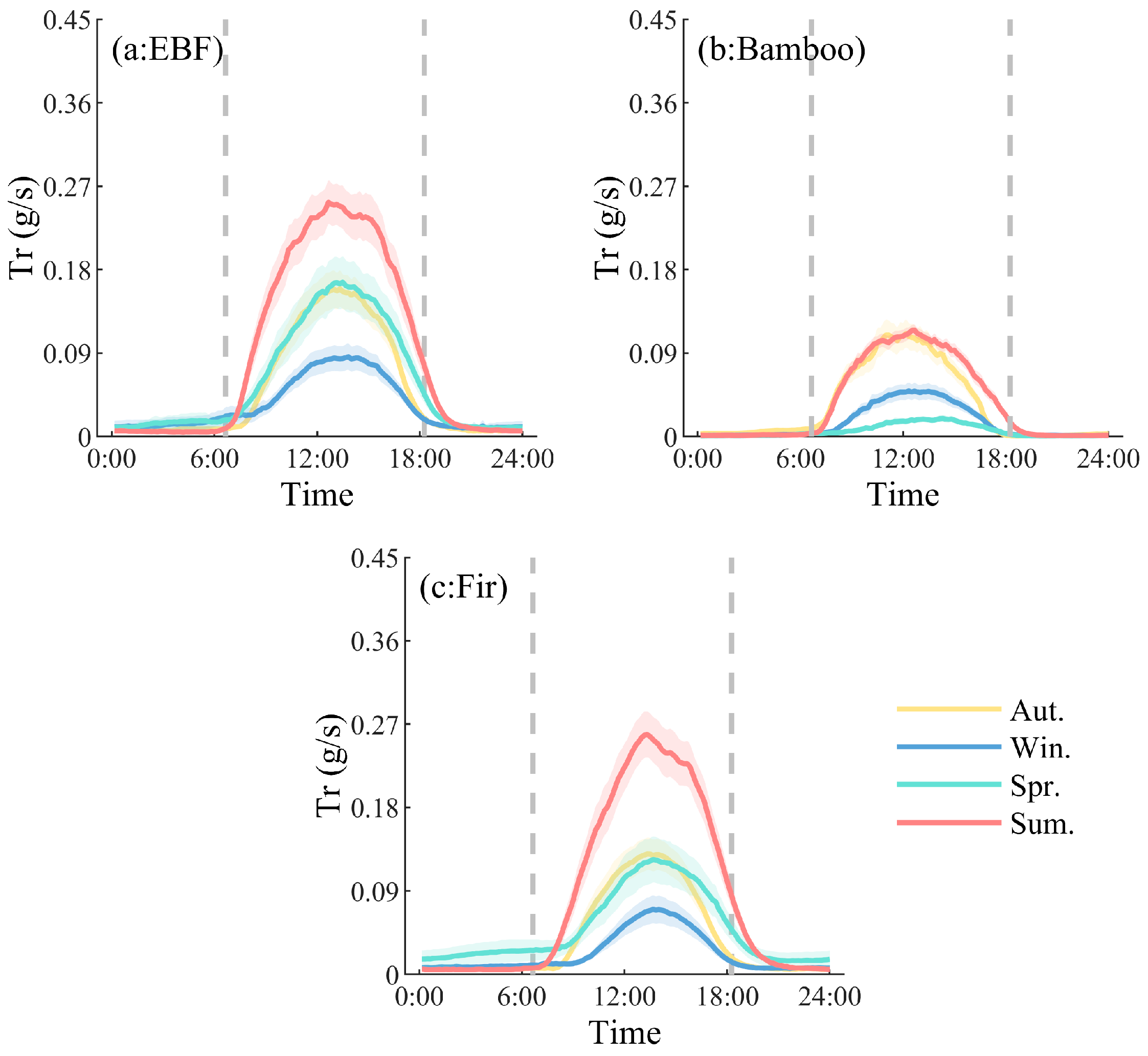

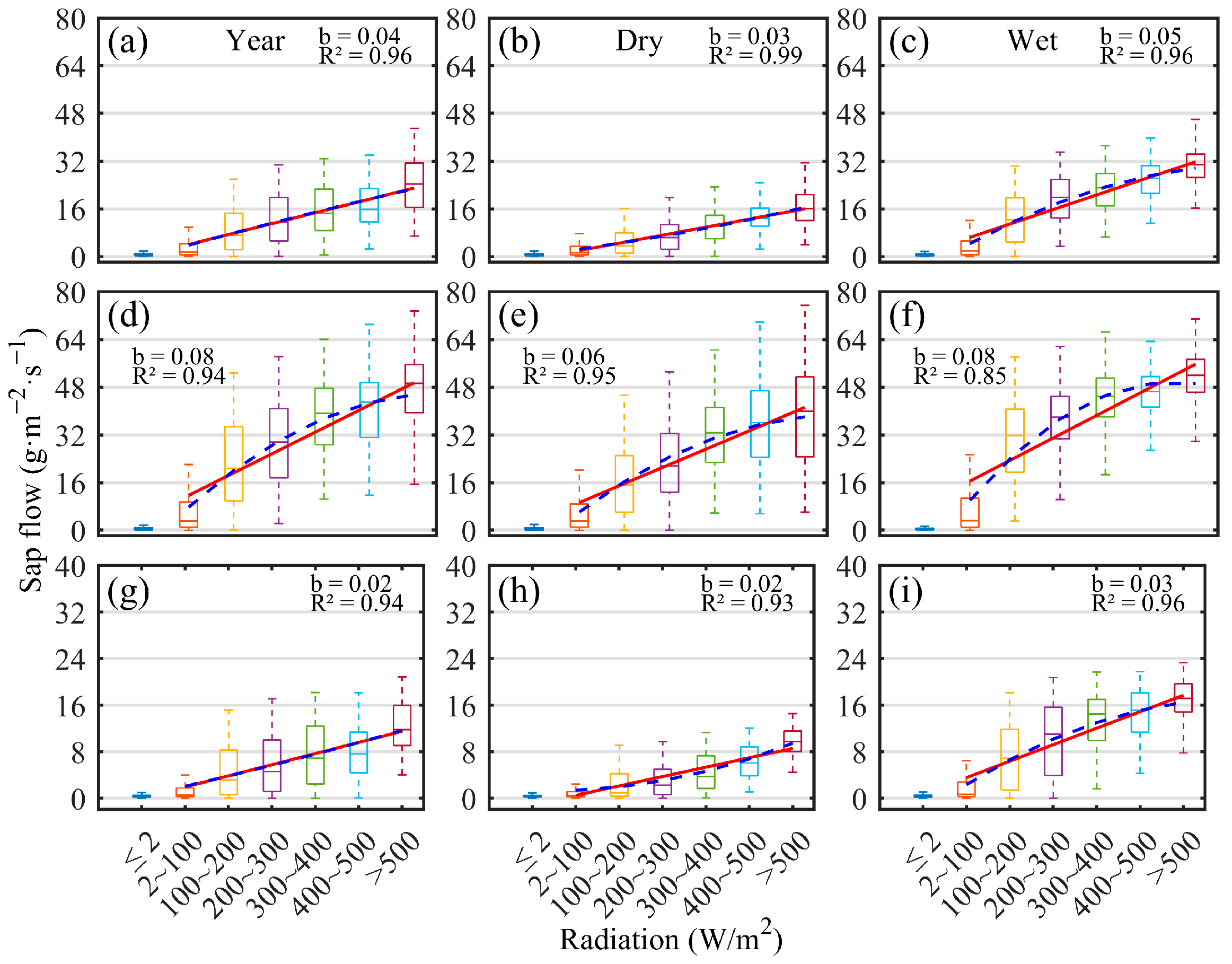

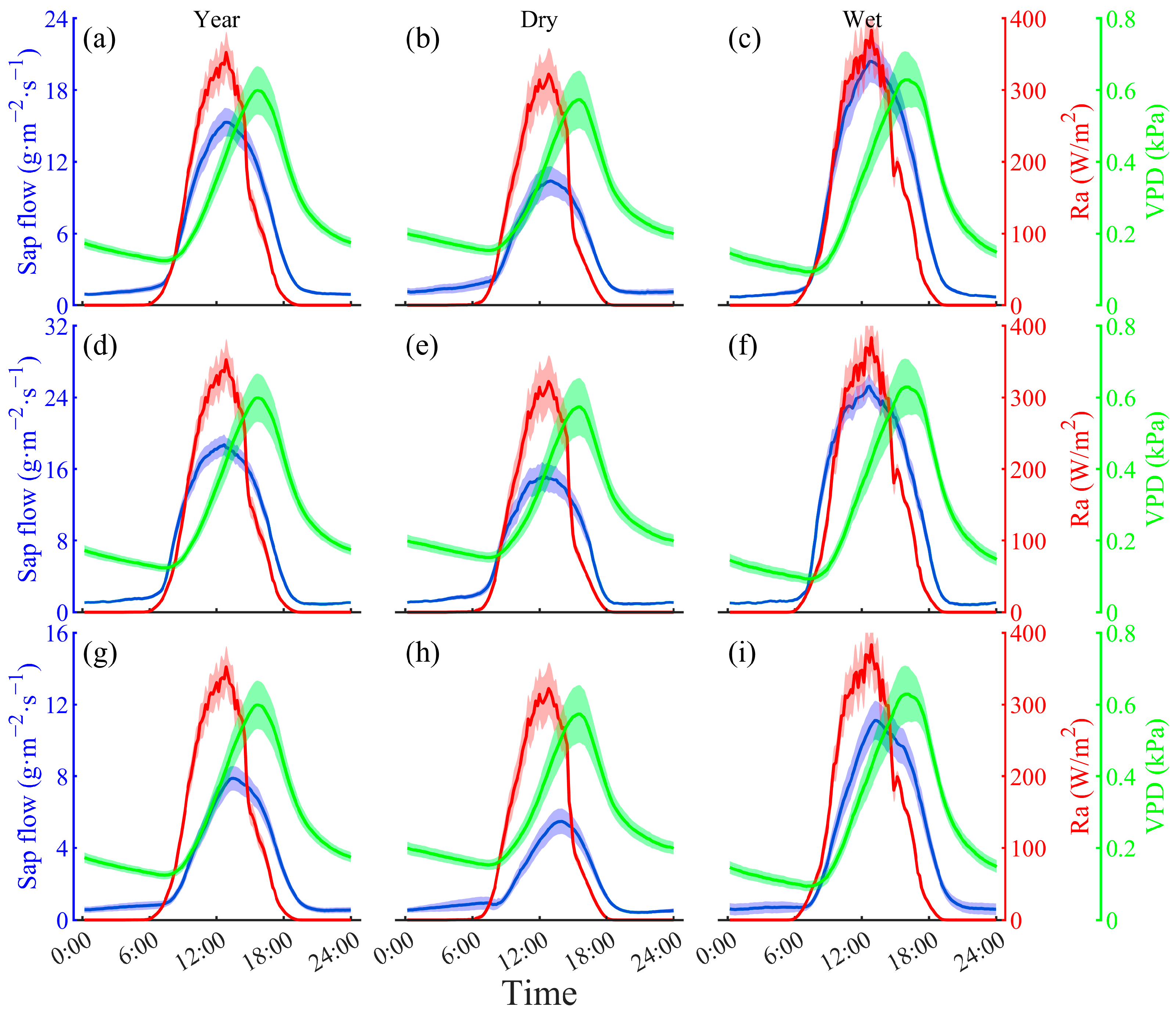

| Site | Lon (°) | Lat (°) | DBH (cm) | DEM (m) | Slope (°) | Aspect | Forest Type | Dominant Species (Amount) | Relative Dominance (%) |
|---|---|---|---|---|---|---|---|---|---|
| Dutree | 113.3508 | 24.4685 | 13.38 ± 5.64 | 292 | 11.87 | Southeast | EBF | Heptapleurum heptaphyllum (3); Litsea elongata (1); others (2) | 42.6; 27.4; 30 |
| LAO1 | 113.3530 | 24.4740 | 9.53 ± 1.27 | 392 | 8.21 | Northeast | EBF | Myrsine seguinii (2); Diospyros morrisiana (3); Daphniphyllum oldhamii (1) | 26.3; 47.8; 31.9 |
| LAO2 | 113.3529 | 24.4744 | 12.48 ± 6.90 | 391 | 10.20 | North | EBF | Myrsine seguinii (1); Litsea elongata (1); others (4) | 12.7; 19.7; 67.6 |
| Dubam | 113.3508 | 24.4686 | 12.26 ± 5.87 | 294 | 11.45 | East | Bamboo | Dendrocalamus latiflorus (6) | 100 |
| Midfir | 113.3539 | 24.4632 | 14.43 ± 4.63 | 372 | 9.16 | East | ENF | Cunninghamia lanceolata (5); Vernicia fordii (1) | 86.1; 13.9 |
| Vegetation Types | Indicates | PC1 | PC2 | PC3 | PC4 |
|---|---|---|---|---|---|
| EBF | Eigen value | 3.88 | 2.66 | 1.41 | 1.03 |
| Percentage of variance (%) | 35.30 | 24.18 | 12.81 | 9.37 | |
| Cumulative variance (%) | 35.30 | 59.48 | 72.29 | 81.66 | |
| Bamboo | Eigen value | 4.12 | 2.33 | 1.41 | 1.06 |
| Percentage of variance (%) | 37.43 | 21.23 | 12.78 | 9.66 | |
| Cumulative variance (%) | 37.43 | 58.66 | 71.44 | 81.10 | |
| Fir | Eigen value | 3.80 | 2.71 | 1.39 | 1.03 |
| Percentage of variance (%) | 34.53 | 24.64 | 12.60 | 9.34 | |
| Cumulative variance (%) | 34.53 | 59.17 | 71.77 | 81.11 |
| Forest Type | Time Scales | Regression Equation | Main Contribution (%) |
|---|---|---|---|
| EBF | Year | Js = −0.0374 + 0.0004·Ra + 0.0027·Ta + 0.0601·VPD | Ra: 79.4; Ta: 10.2; VPD: 10.4 |
| Dry | Js = 0.0078 + 0.0002·Ra + 0.0540·VPD | Ra: 75.7; VPD: 24.3 | |
| Wet | Js = −0.1345 + 0.0004·Ra + 0.0065·Ta + 0.0494·VPD | Ra: 86.6; Ta: 8.2; VPD: 5.2 | |
| Bamboo | Year | Js = −0.0038 + 0.0001·Ra + 0.0006·Ta | Ra: 89.3; Ta: 10.7 |
| Dry | Js = −0.0042 + 0.0001·Ra + 0.0008·Ta | Ra: 83.4; Ta: 16.6 | |
| Wet | Js = −0.0642 + 0.0001·Ra + 0.0028·Ta | Ra: 63.9; Ta: 36.1 | |
| Fir | Year | Js = −0.0403 + 0.0003·Ra + 0.0026·Ta + 0.0861·VPD | Ra: 59.3; Ta:13.2; VPD: 27.6 |
| Dry | Js = −0.0021 + 0.0002·Ra + 0.0879·VPD | Ra: 53.6; VPD: 46.4 | |
| Wet | Js = −0.1236 + 0.0003·Ra + 0.0059·Ta + 0.0781·VPD | Ra: 68.7; Ta:11.1; VPD: 20.2 |
| Indicator | Time Scale | EBFs | Bamboo Forests | Fir Forests | |||
|---|---|---|---|---|---|---|---|
| R | Time Lag (STD) | R | Time Lag (STD) | R | Time Lag (STD) | ||
| Ra | Year | 0.68 | 29.4 (16.4) | 0.74 | 1.7 (3.7) | 0.74 | 68.0 (4.0) |
| Dry | 0.67 | 53.8 (24.2) | 0.72 | 10.0 (0) | 0.83 | 94.0 (4.9) | |
| Wet | 0.76 | 21.3 (12.7) | 0.81 | 0 (0) | 0.76 | 48.0 (7.5) | |
| VPD | Year | 0.58 | −146.3 (24.7) | 0.66 | −171.7 (6.9) | 0.67 | −102.0 (7.5) |
| Dry | 0.59 | −127.5 (25.9) | 0.66 | −170.0 (11.0) | 0.75 | −90.0 (9.0) | |
| Wet | 0.65 | −153.7 (28.5) | 0.72 | −178.3 (13.4) | 0.71 | −112.0 (7.5) | |
Disclaimer/Publisher’s Note: The statements, opinions and data contained in all publications are solely those of the individual author(s) and contributor(s) and not of MDPI and/or the editor(s). MDPI and/or the editor(s) disclaim responsibility for any injury to people or property resulting from any ideas, methods, instructions or products referred to in the content. |
© 2025 by the authors. Licensee MDPI, Basel, Switzerland. This article is an open access article distributed under the terms and conditions of the Creative Commons Attribution (CC BY) license (https://creativecommons.org/licenses/by/4.0/).
Share and Cite
Chen, H.; Tang, G.; Jiang, N.; Ren, Z.; Fang, X.; Chen, Y. Seasonal Dynamics, Environmental Drivers, and Hysteresis of Sap Flow in Forests of China’s Subtropical Transitional Zone. Forests 2025, 16, 1480. https://doi.org/10.3390/f16091480
Chen H, Tang G, Jiang N, Ren Z, Fang X, Chen Y. Seasonal Dynamics, Environmental Drivers, and Hysteresis of Sap Flow in Forests of China’s Subtropical Transitional Zone. Forests. 2025; 16(9):1480. https://doi.org/10.3390/f16091480
Chicago/Turabian StyleChen, Houbing, Guoping Tang, Nan Jiang, Zhongkai Ren, Xupeng Fang, and Yaoliang Chen. 2025. "Seasonal Dynamics, Environmental Drivers, and Hysteresis of Sap Flow in Forests of China’s Subtropical Transitional Zone" Forests 16, no. 9: 1480. https://doi.org/10.3390/f16091480
APA StyleChen, H., Tang, G., Jiang, N., Ren, Z., Fang, X., & Chen, Y. (2025). Seasonal Dynamics, Environmental Drivers, and Hysteresis of Sap Flow in Forests of China’s Subtropical Transitional Zone. Forests, 16(9), 1480. https://doi.org/10.3390/f16091480






